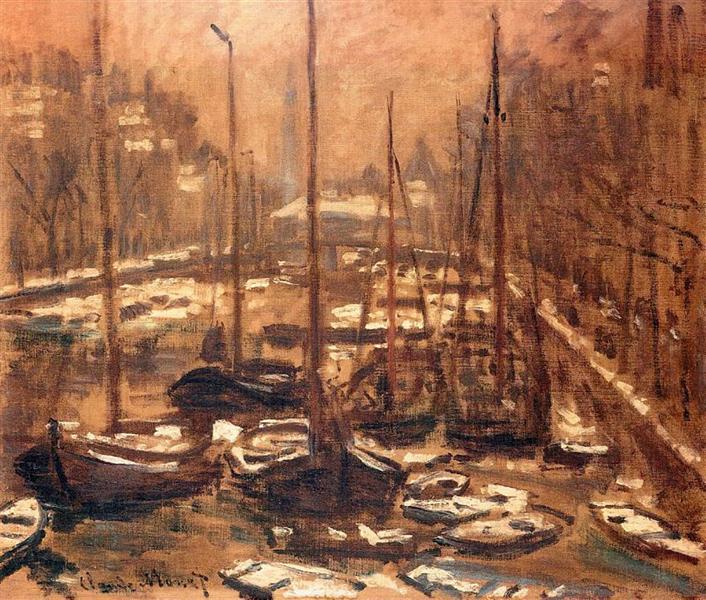Описание
Claude Monet's "Geldersekade De Amsterdam Invierno" (Winter Landscape of Amsterdam), painted in 1874, stands as a vivid example of the artist's skill in capturing the atmosphere and spirit of a winter landscape. In this painting, Monet transports us to the canals of Amsterdam, reflecting not only the beauty of the urban environment, but also the cold and melancholic atmosphere that characterizes the winter season.
The composition of the work is balanced and harmonious. Monet chooses a view that includes both the canals and the buildings that surround them, creating a sense of depth and space that invites the viewer to explore the connection between architecture and nature. The architectural lines of the buildings blend into the frozen landscapes, while the partially frozen waters of the canal reflect a palette that oscillates between cold and warm tones. This interaction creates a visual contrast that is characteristic of Monet's impressionist style, where light and color play a fundamental role in the perception of the landscape.
The palette used in “Geldersekade Amsterdam Winter” is remarkably restrained and nuanced, with greys, blues and whites predominating, evoking the winter cold. Yet, despite the apparent simplicity of the tonality, Monet manages to infuse the work with an inherent vitality, coming close to capturing light in the cold. The quick, loose brushstrokes, typical of Impressionism, suggest movement and life, even in a setting where nature seems dormant.
In the foreground, there are hints of human activity and certain figures, although these are almost schematic, perhaps highlighting Monet's intention to bring the landscape to life without distracting the viewer with the individuality of the characters. This allows the focus to remain on the landscape itself, highlighting how humans coexist with nature. The depiction of everyday life, although subtly suggested, is a manifestation of Monet's commitment to showing the interaction between environment and man, a recurring theme in his work.
Interestingly, this painting is part of a period when Monet was exploring light and colour in increasingly sophisticated ways, moving away from the more detailed representation that characterised his early work. "Geldersekade Amsterdam Winter" is a testament to his stylistic evolution, demonstrating a mastery of technique that challenges the artistic conventions of his time.
The work also sits within the broader context of the Impressionist movement, which began to gain acceptance in the 1870s. Monet’s interest in exploring natural light and atmospheric effects resonates with other works by his contemporaries, such as Camille Pissarro and Édouard Manet. Similarities in the depiction of urban and rural spaces characterise this generation of artists, who sought to capture fleeting moments of the world around them.
In conclusion, “Geldersekade Amsterdam Winter” is not only a captivating depiction of a winter landscape in Amsterdam, but also a compendium of the innovative spirit of Impressionism. Monet, through his keen observation and technical mastery, makes the viewer not only see but feel the cold and stillness of winter, thus revealing the beauty of the ephemeral and the everyday in nature. This work stands as a reminder of art’s ability to capture moments, emotions and the intrinsic relationship between humans and their environment.
KUADROS ©, a famous painting on your wall.
Hand-made oil painting reproductions, with the quality of professional artists and the distinctive seal of KUADROS ©.
Painting reproduction service with satisfaction guarantee. If you are not completely satisfied with the replica of your painting, we will refund 100% of your money.

